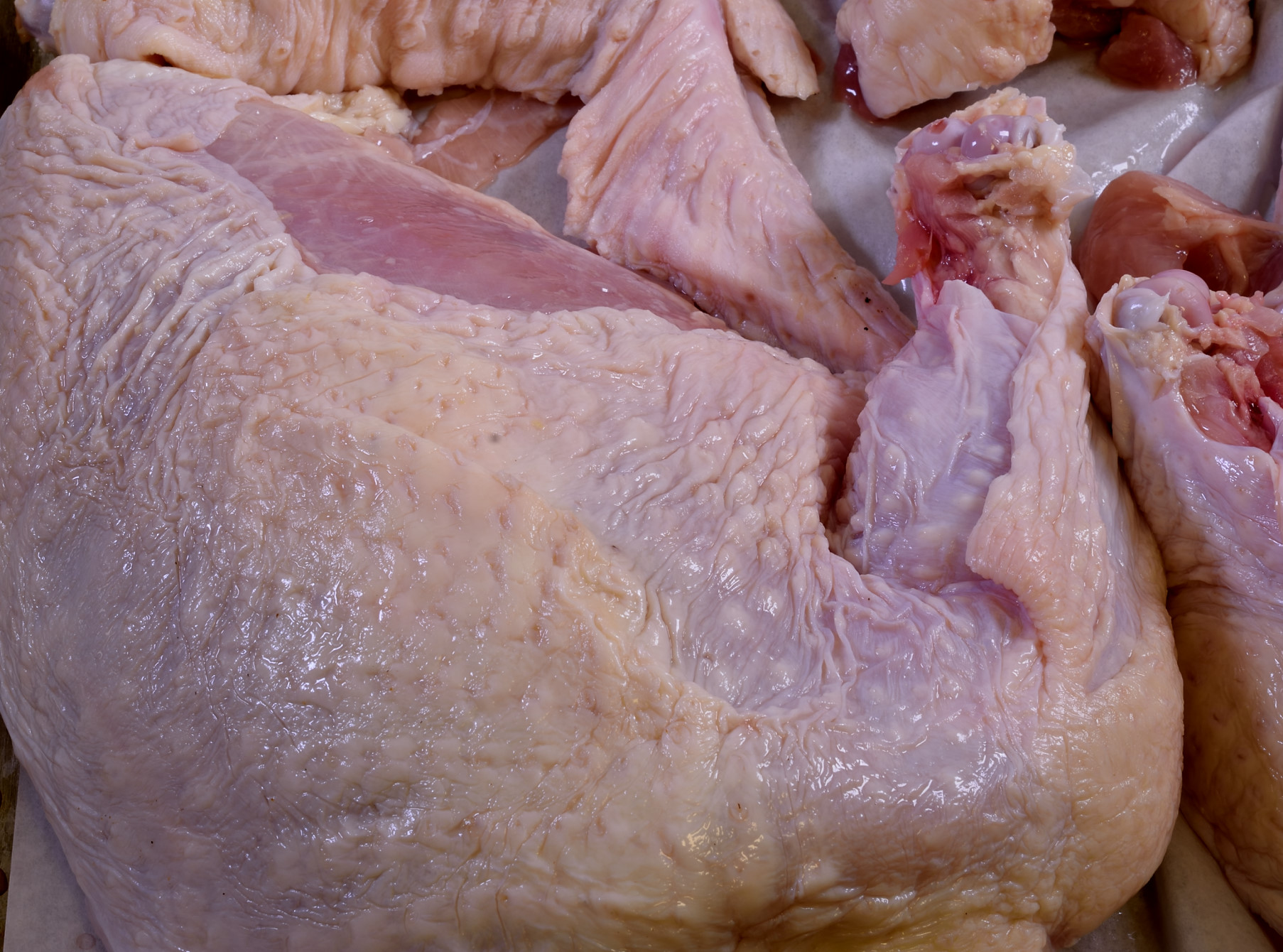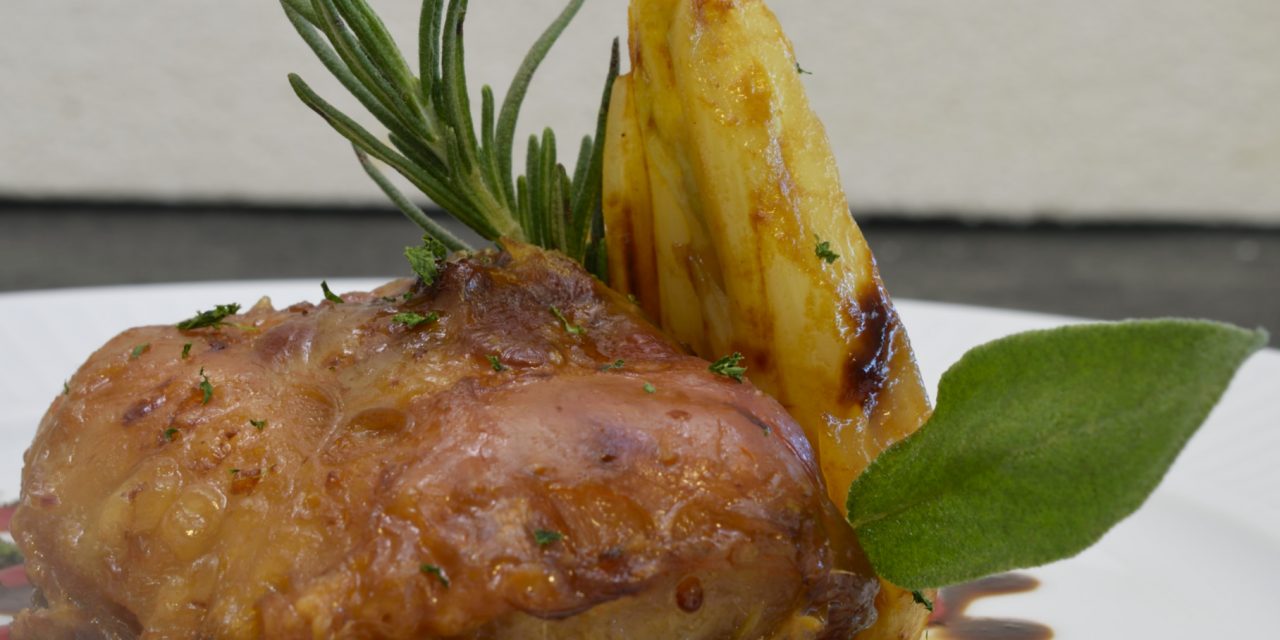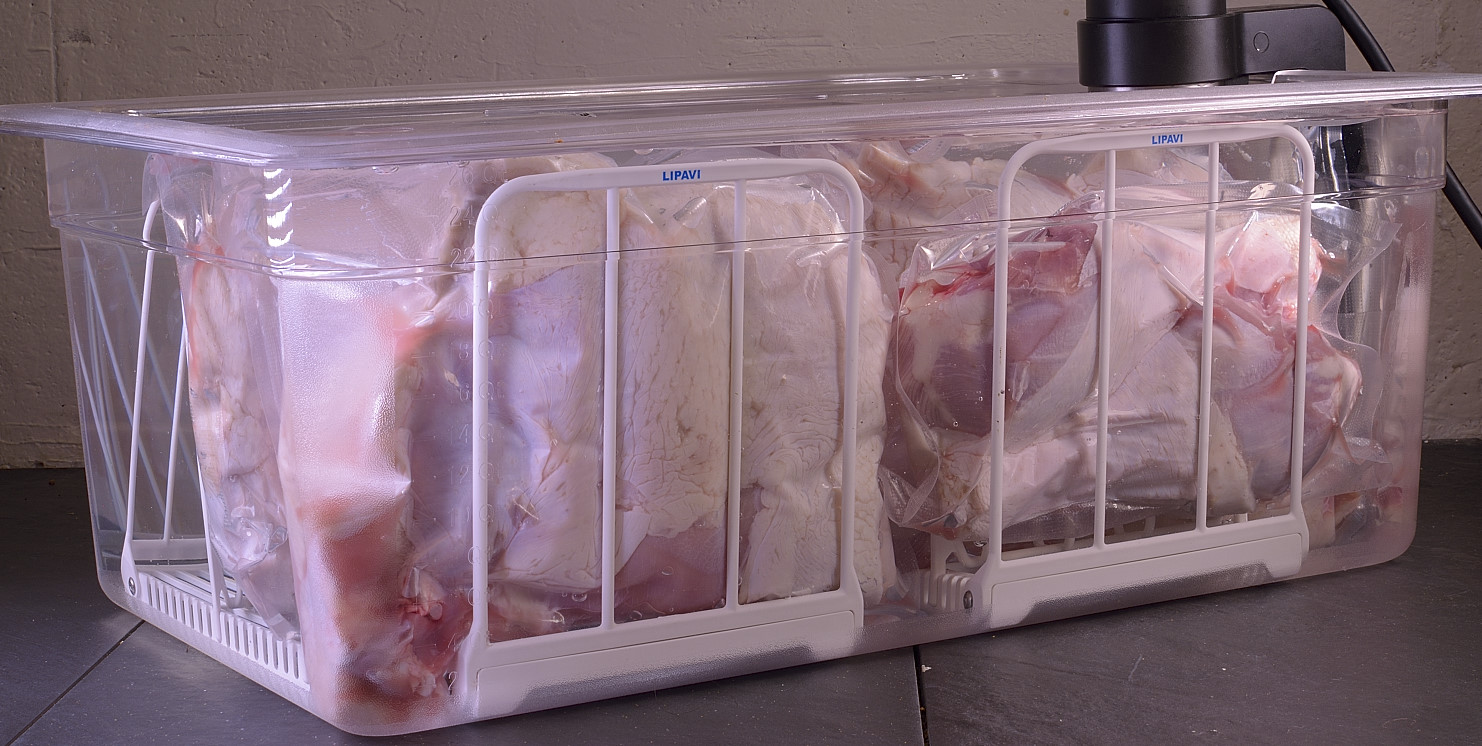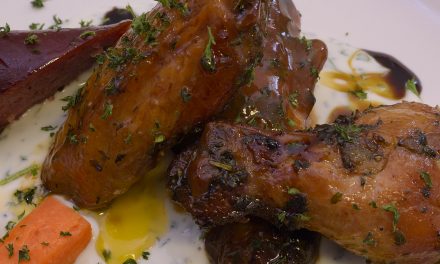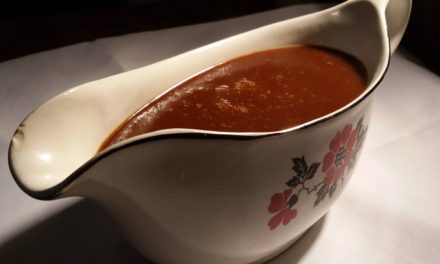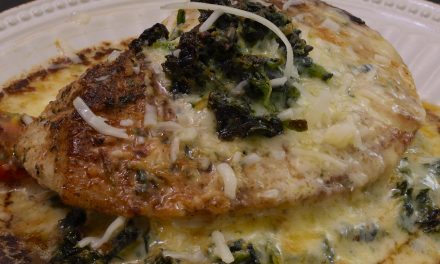You don’t have to wait for Thanksgiving to buy a turkey
Thanksgiving has evolved over the last 60 years, as has the preparation of the Thanksgiving turkey itself. I can remember just about that far back. I just can’t remember what I was doing a minute ago. Even though the actual holiday was first mentioned in the 16th century, it wasn’t until 1941 that President Franklin D. Roosevelt’s administration officially changed the national Thanksgiving Day from the last Thursday in November to the fourth Thursday. Two years earlier, Roosevelt had used a presidential proclamation in an attempt to achieve this change–he reasoned that earlier celebration of the holiday would give the country an economic boost.
No, it’s not a Steely Dan song.
The term Black Friday now refers to the beginning of the Christmas shopping season. The term was actually coined in 1931 during the Great Depression as reference to an apocalyptic stock market event. Before that, not only was the Thanksgiving tradition much less formalized, there was either no official day or the states were left to decide when to celebrate in their own principalities.
By the late 1960’s, food safety scientists were coming to the realization that stuffing the bird wasn’t really such a good idea. I can almost hear cooks saying, “Well if we’re not going to stuff it, is there really any reason to try and fit that gigantic thing in our tiny oven?” Chefs started boning out turkeys to roast. It is more energy efficient and reliable. It cooks faster, and the removed bones can be used to make stock and sauce before the event.
By the 70’s, chefs and large producers were exploring the many virtues of sous vide. Turkey was a perfect candidate for exploitation. Yield from turkeys is better than a lot of other popular meat products, and dressed turkeys (or undressed, I guess!) weigh about 75% of the live turkey at about 12 weeks old. How many turkeys does it take to create a ton of feathers, I wonder?
Bag it and Tag it.
When you visit the deli counter at your local market, turkey dominates the landscape–smoked, roasted, formed, shaped, “natural,” all tightly sealed in those hermetic plastic wrappers. There’s a hint for you right there. Any time you see those perfectly formed vacuum tight plastic sheaths on meat in the deli case, you can be sure the products were prepared sous vide. Big producers know the value of pasteurizing their products, if only for reasons of shelf life. It’s much easier and cheaper to achieve a pasteurized product if it’s sealed away from the external environment before cooking, as opposed to after. Coloring is not achieved by heat, but by caramel coloring and the like; perfectly safe and wholesome, albeit somewhat less romantic than the traditional methods. If that turkey breast is labeled “smoked,” there’s a good chance it never got close to a smoker, but, rather, a bottle. *sigh*. Next we’re going to find out that there’s no such thing as a natural blonde, either. Wait. What?
Turkey is an awesome product any time of the year, and 88% of Americans eat turkey on Thanksgiving. 46 million turkeys are consumed each Thanksgiving. Americans eat almost 800 million pounds of turkey every year, an increase of 100% since 1970 (just about the time that producers were converting to SV pasteurization). 250 million turkeys will have been raised in the States this year. Of all the turkey consumed, only about 30% is consumed during the Thanksgiving/Christmas/Easter holidays.
Toms have a much better meat/bone yield and less moisture than hens, which are almost all sold whole, popular deep fried. Toms are commonly cut up and used to make all the sausage and specialty turkey products, but Toms are also really the best for roasting “holiday style.” Hens are rarely above 15 lbs. A 20-25 lb. Tom, or even larger, gives the best final product. At home, allow 1 lb. per person, because people really like to gluttonize holiday turkey. Oh, the naps!
The Story of Wilbur
I had a friend in California, Wilbur Norman. Wilbur was from Oklahoma and wore a blue fishing cap that he would expressively tilt forward, backward and sideways as he would regale me with stories from the Dust Bowl days, a long ashed Salem cigarette dangling from his mouth. Bless that man’s heart, he could tell a story. One in particular, his family raised livestock of all kinds when he was a kid, him and his 8 or 9 brothers and 1 sister. I forget the exact number. Chickens and turkeys were raised together for a number of reasons. For one thing, turkeys seemed to have the habit of abandoning their eggs, which Bantam hens would promptly roll into their nests to hatch. Turkey eggs are just about the same size as chicken eggs.
Turkey poults (chicks) were so stupid, Wilbur would inform me, that they needed to be trained to eat in order to avoid starving right out of the shell. This was accomplished by their chick companions, who randomly pecked by instinct. If not brought in from the rain, the poults would tilt their heads back and drown, Wilbur would exclaim, twinkle eyed. He might have been gaslighting me.
On a cold night, all the chicks and poults would pile up in a corner of the shed where they slept, and if you didn’t go in there with a broom handle and stir them up periodically, they would smother the poults nearest the walls. Now, I have read data that these legends are just that — tall stories. But, it doesn’t matter. Wilbur was entitled to exaggerate, if only because he did it so casually and warmly.
I really loved that man. He had a series of heart attacks before I had even met him, and, one day, I stopped by his house hoping to hang out. He kept hundreds of rabbits for the University Lab Department, and he had taught me how to determine the sex of a rabbit — no mean feat. I knocked on the door, and after a few minutes, his otherwise rather unfriendly widow came to the door and gave us the news, not sobbing but a little tearful. I was brokenhearted and I timidly asked what happened.
She said “Oh, nothing, really. He got up at sunrise, just like he always did, went down into the basement where he started his daily routine. He must have laid down on his little bed down there and just curled up and died. The idiot. I told him to go to the doctor. And now I’m left with all these rabbits and chickens and ducks to figure out how to get rid of.” She shook her head mournfully, and closed the door.
Okay, let’s defrost a Turkey!
There are a few inadvisable ways to defrost a frozen turkey. Usually stored at 0 F/-17 C, very few guidelines are provided as to what to do next. We all WANT to defrost our turkeys in the refrigerator, but, gee, how long is that actually going to take? Turkeys are frequently defrosted at room temperature, but that is really not a very good idea. The outside regions will achieve 70F-90F within a few hours while the center will still be frozen quite solid for up to 36 hours — too long. This means that Salmonella, if present, are being strongly encouraged to reproduce–even sealed up in that bag. They don’t care. Salmonella and most other pathogens are a lot like humans, in that they are VERY active between the temperatures of 70 F and 90 F.
The fix for this is generally considered to be to submerge them in water, but that really does very little besides being pretty darned difficult. If the bag leaks one little bit, you are dissolving salmonella into the water, which then comes in contact with your hands as you try to wrestle that monster over to the sink, dripping the pathogenic solution all along the way. Not to mention soaking your sleeves with it, and, let’s be honest, turkeys frequently take their final flight towards the floor as part of the process. Great. Salmonella on the floor, and everywhere else, not to mention the splatter from impact.
If you have a vessel large enough, and most of us don’t, you can remove the plastic wrapper, submerge Tom in the sink, and then run cold tap water (typically around 70 F/21 C) over him. This is impossible unless you have one of those devices that plugs into the drain and extends upwards to just below the upper limit of the sink so that water flows into it after filling. You see those in restaurants, but not at home very often. This method also uses a LOT of water. So we really are left with the refrigerator, with the unsettling prospect of having to troubleshoot the process as our first holiday crisis.
Give it a WEEK!
That’s right. A frozen turkey will defrost perfectly in a functioning refrigerator in a week, even if it’s more than 20 lbs. By then you may find a little snow in the cavity, but that’s about it. After that, the turkey can actually be kept in the fridge at least another week without any risk of spoilage. Even if you bought your frozen turkey in the first week of November you will have one less problem to solve when the fourth Thursday rolls around.
Let me introduce you to my friend Tom.
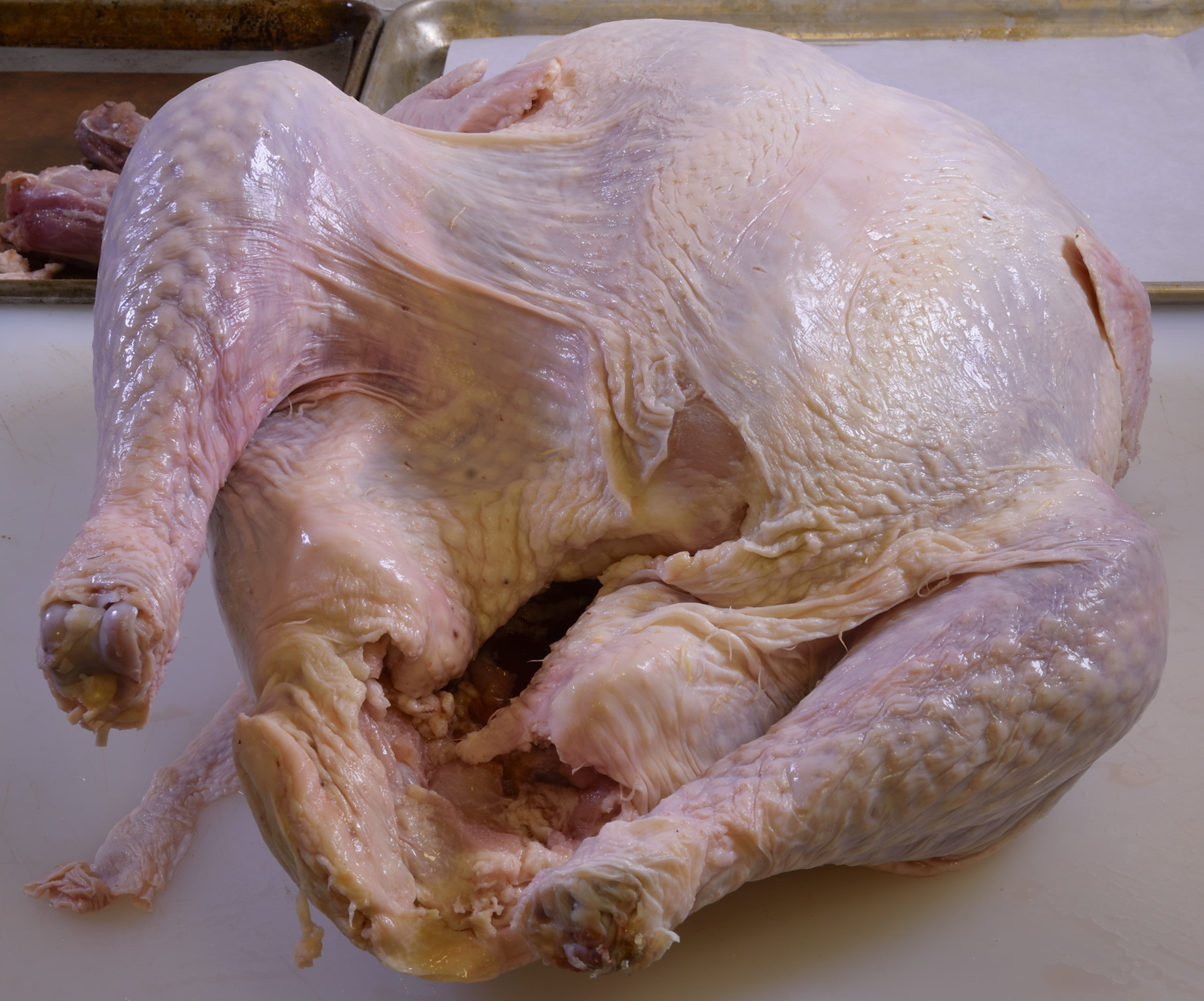
23 lbs. of bird. Not only holiday fare, but everything from Tetrazzini to club sandwiches to soup and beyond. After removing the snow and the giblets from the neck end, it’s really a great idea to have a lot of towels around. Have a 2 gallon bucket of water with 2 oz. of bleach in it to soak contaminated towels. The towels can be reused for clean up. That solution is strong enough to kill Salmonella (it’s a strong alkali), but not strong enough to irritate your skin or even hurt you if you accidentally took a sip. It’s like a swimming pool. Honestly, I kind of like that faint hint of chlorine in the air. I guess it conjures up memories of childhood or something. At this point, the turkey has no smell. Neither does Salmonella. Where was I?
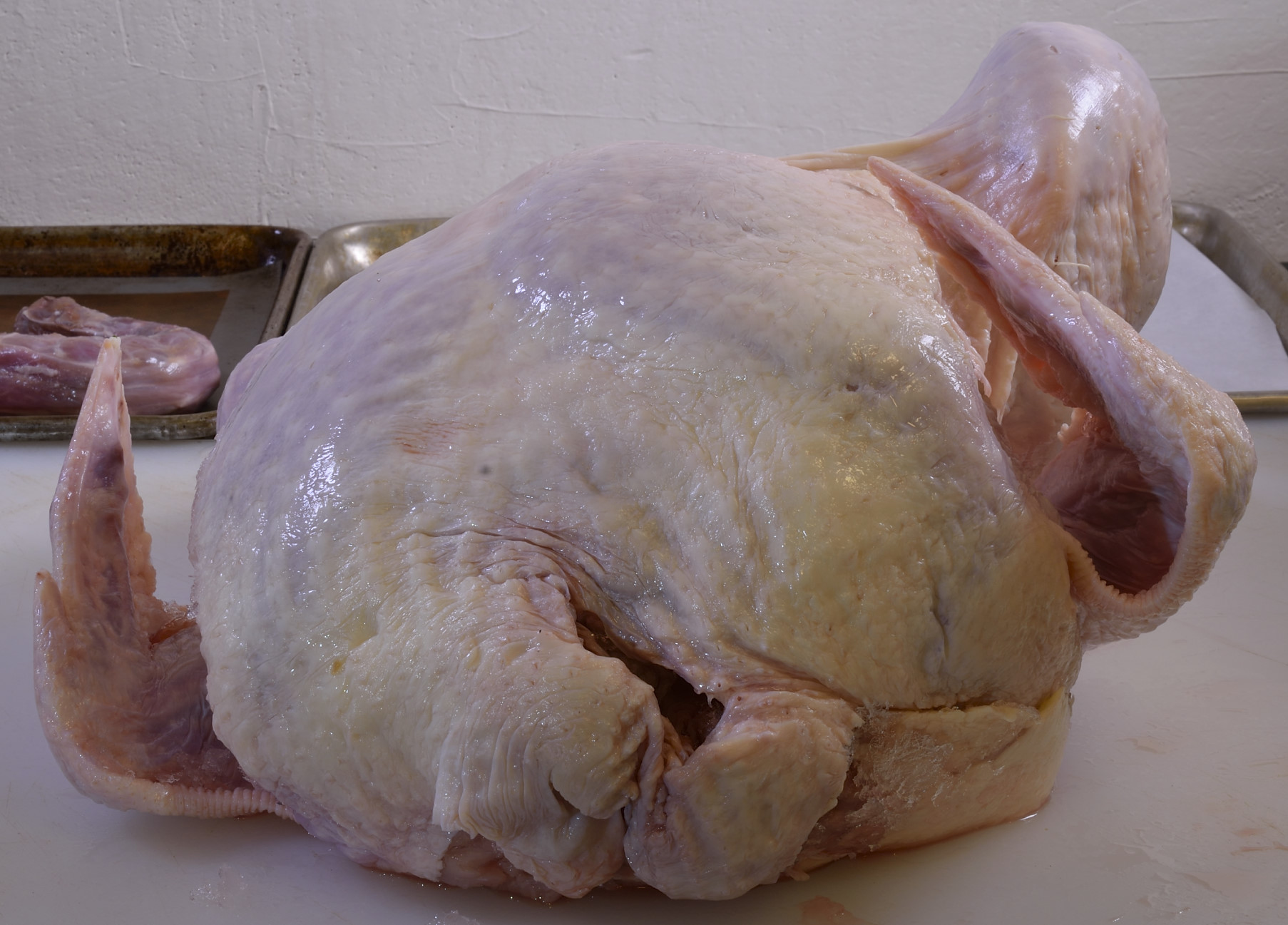
Like the unappetizing idea of skinning a cat, boning a turkey can be done many, many different ways. I thought about this as I was shooting the sequence, to make it as easy as possible for the novice. I was a novice once, too, but that was about 20 K chickens ago, and chickens are done just like turkeys, right down to the wish bone.
Even though the legs are typically removed first, we are going to do the breasts instead. That’s why I have positioned the turkey in this way. This will make the first cut really easy.
There is a moist towel under the cutting board, to keep it from sliding around, and a towel under the turkey, too, for the same reason.
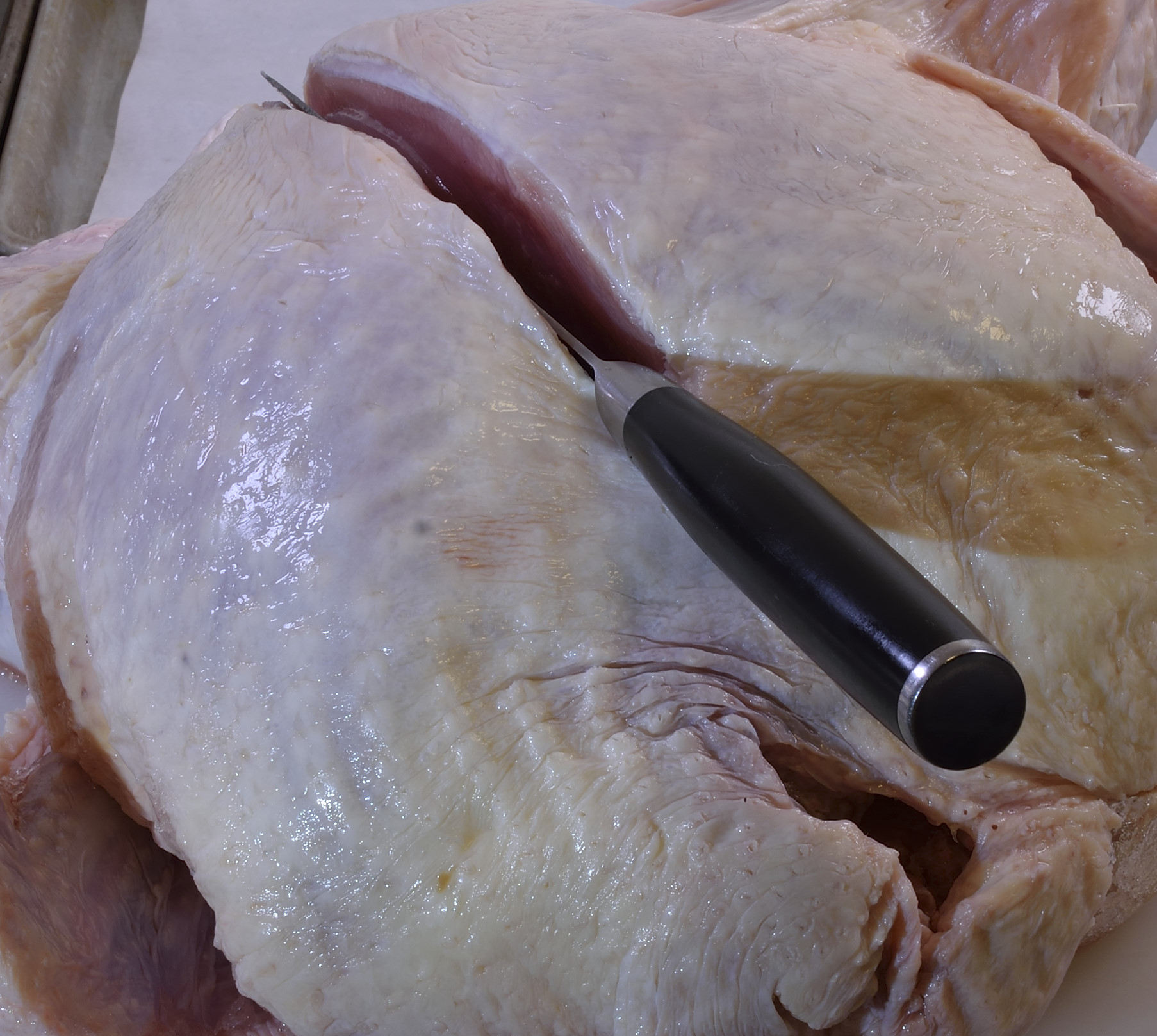
Cleavage, literally.
You can feel the breast bone, the avian equivalent of a sternum, with your finger. There’s kind of a callous between the bone and skin, a little strip of cartilage. Run your favorite knife straight down along that line on the right side of the bone in long smooth strokes. As the blade comes in contact with the wish bone, your angle will slowly guide to the right until you hit the shoulder wing joint.
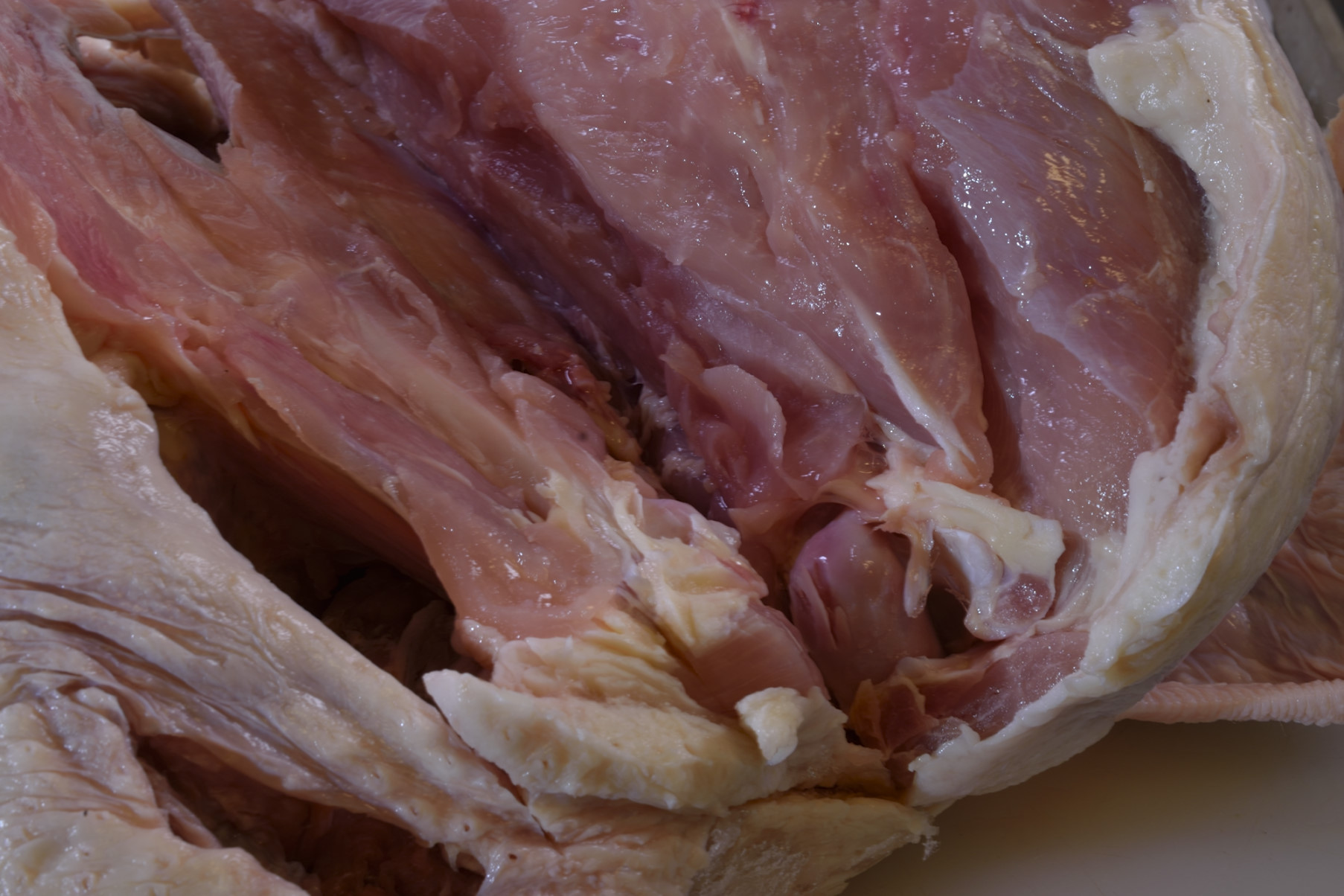
As you cut, the breast will slowly start to sag away from the carcass exposing the joint.
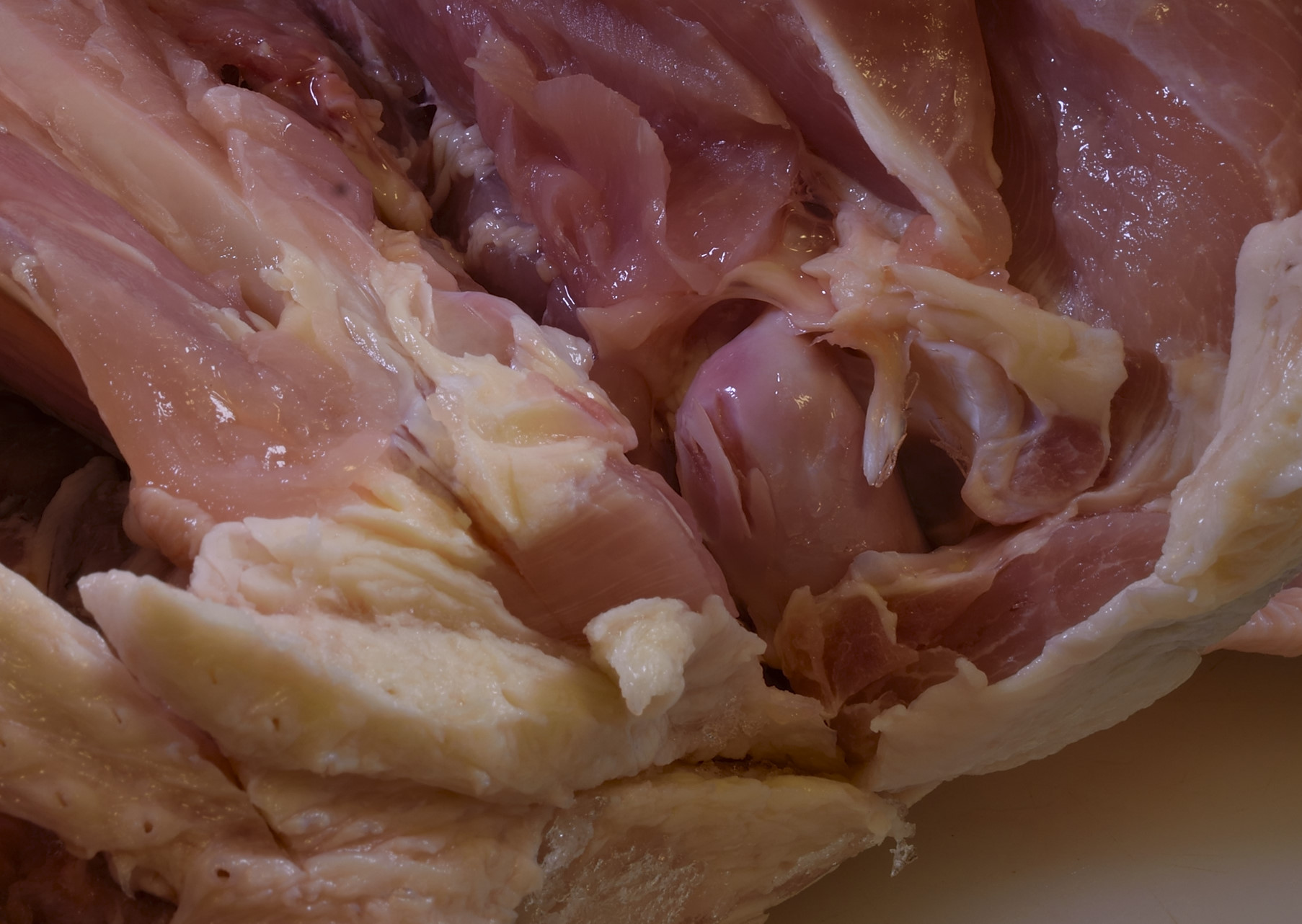
This is an important step in the process, so I have a close up to make it more visible.
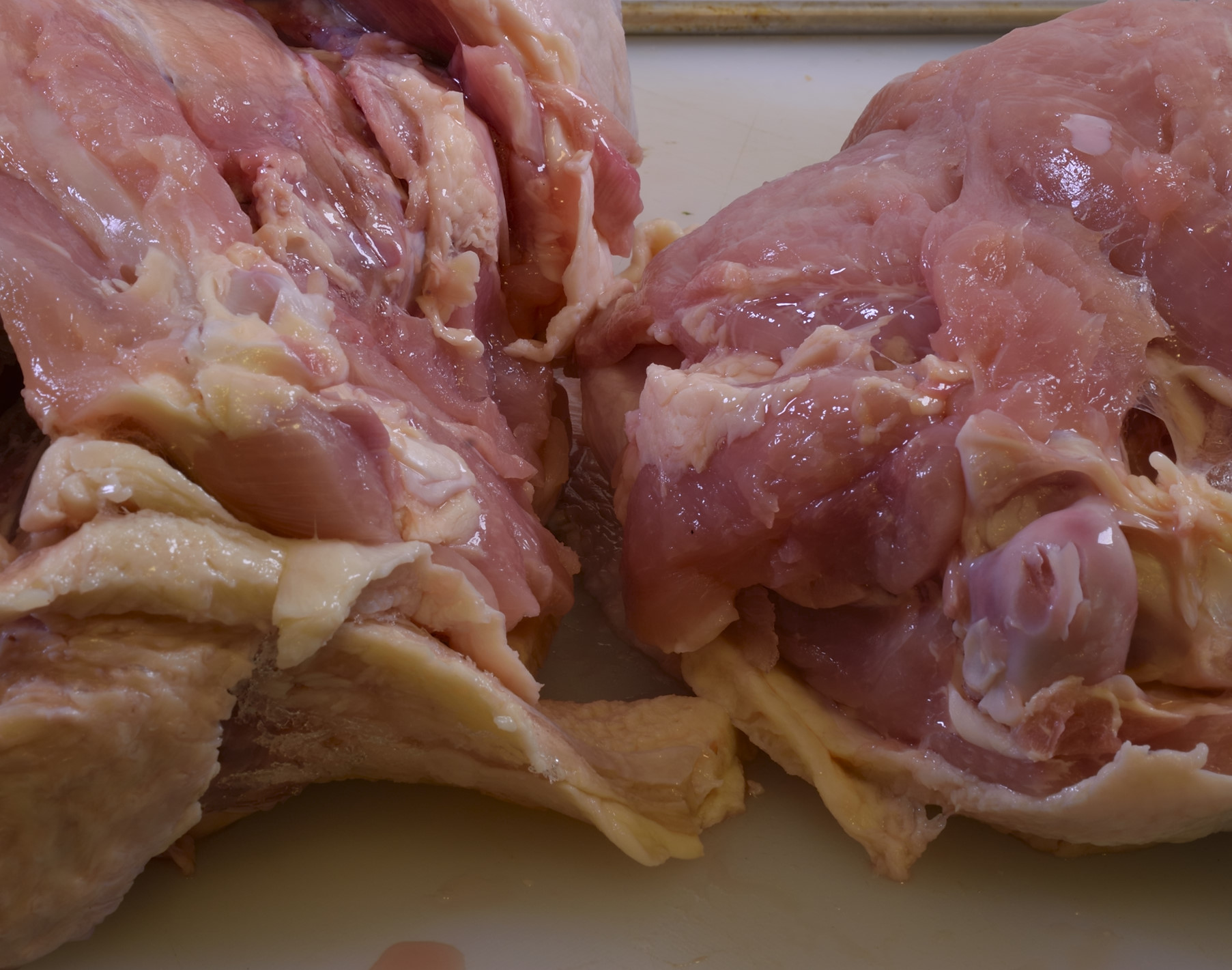
I’ve inserted the point of my wicked knife into that joint, it goes right through. A lot of people get stuck here, and end up scraping to the side as they miss the joint. Next thing you know, you’re sawing like a panicky serial killer.
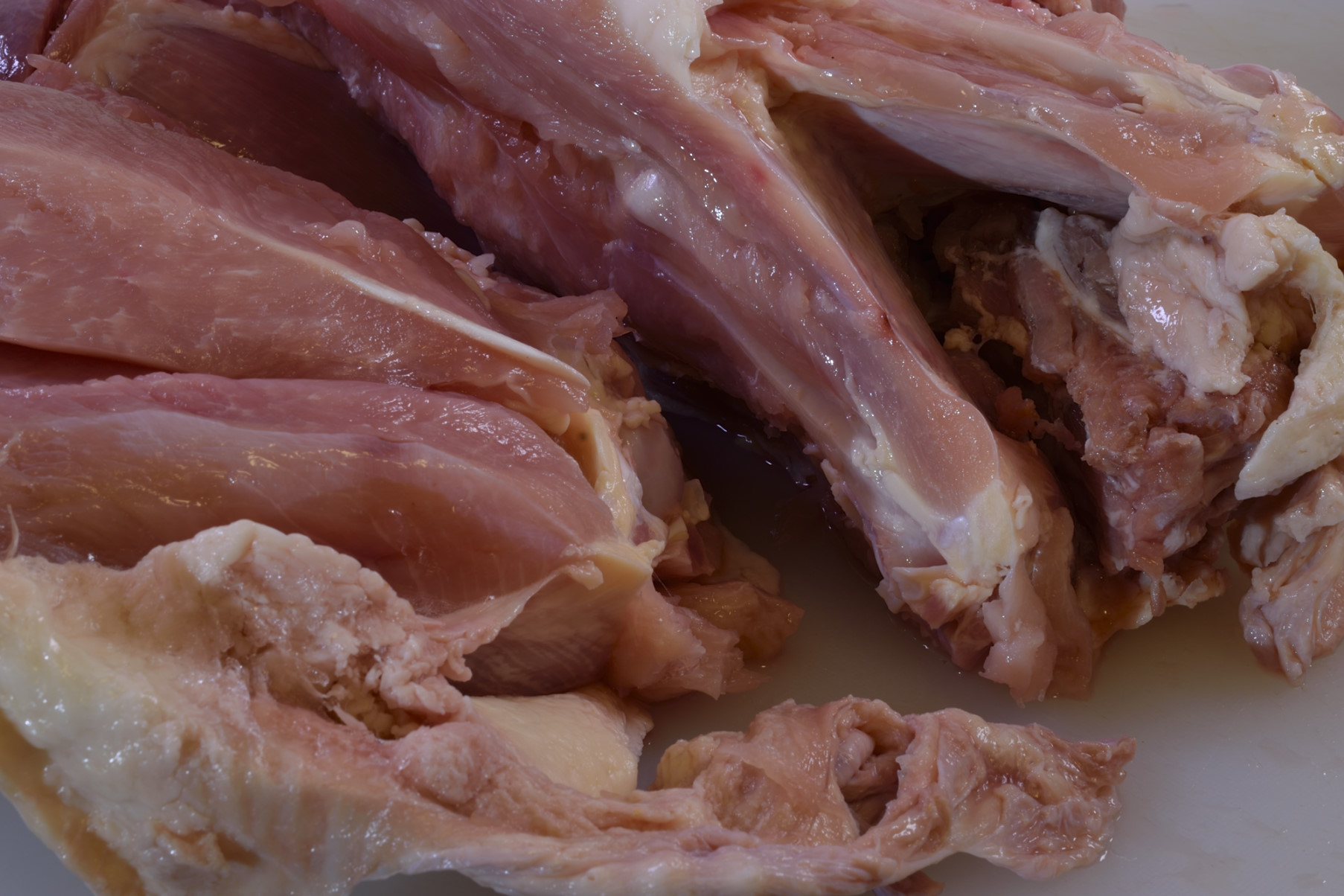
Again, a close up of that pierce. That little white piece of sinew protrudes from the end of the so called “tenderloin,” you see them in the stores once in a while. They are only barely attached to the breast itself, and if you don’t cut through that little white line, the tenderloin will pull right off of the breast.
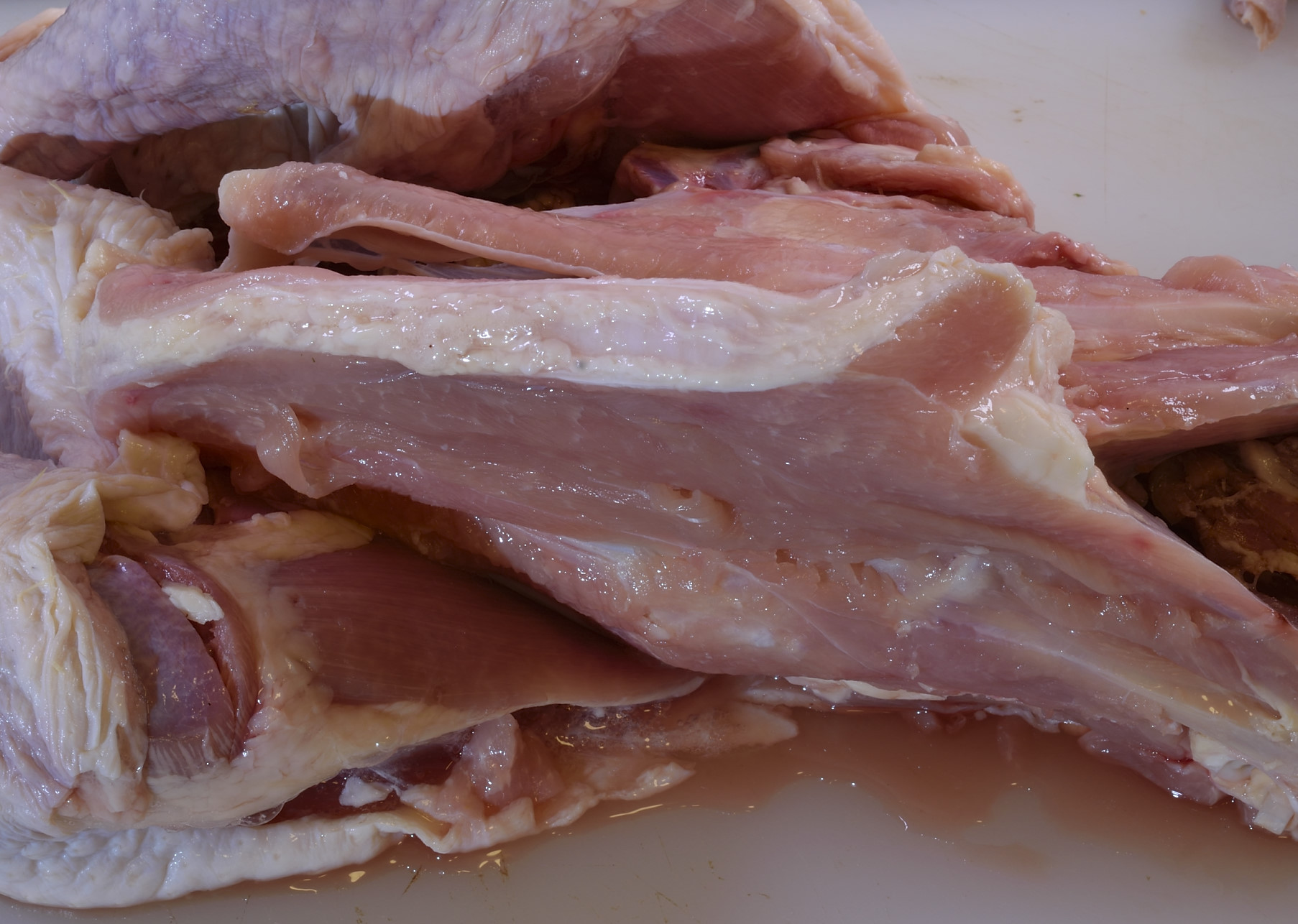
Repeat the procedure with the breast on the other side.
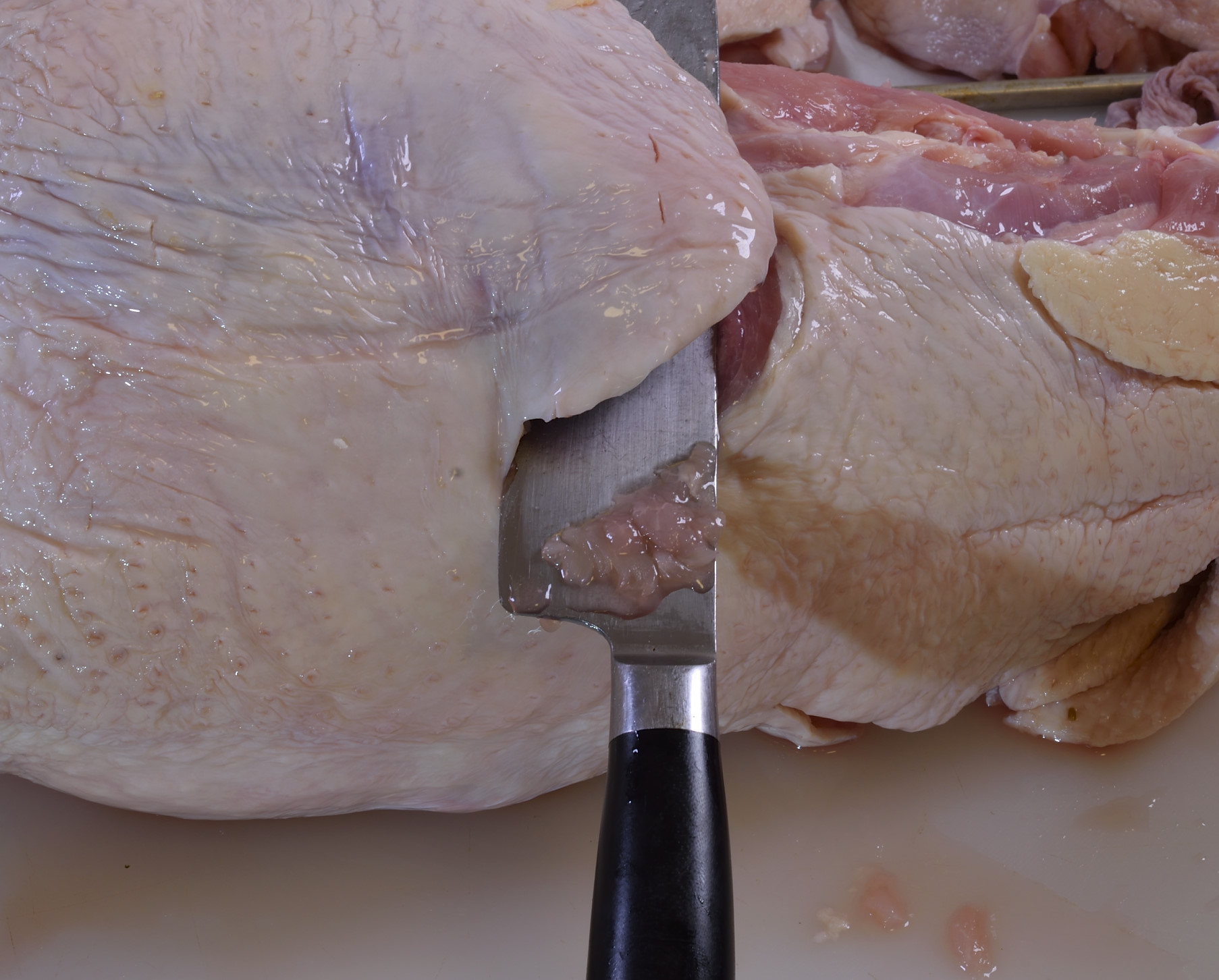
Turn the turkey over and remove the legs–just follow along the bone the best you can.
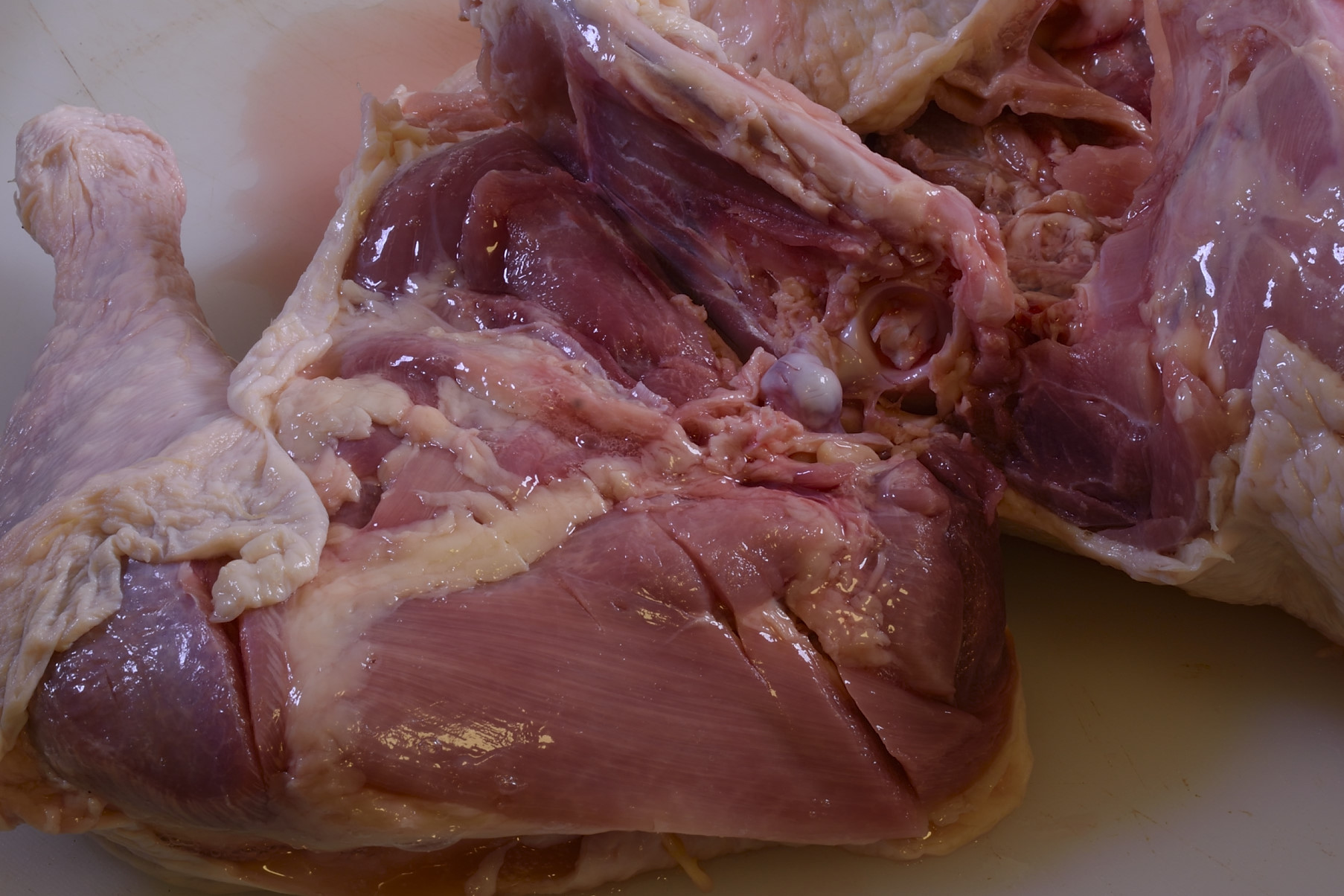
When you get to the joint, you can bend the thigh “the wrong way” and the ball will come out of the socket.
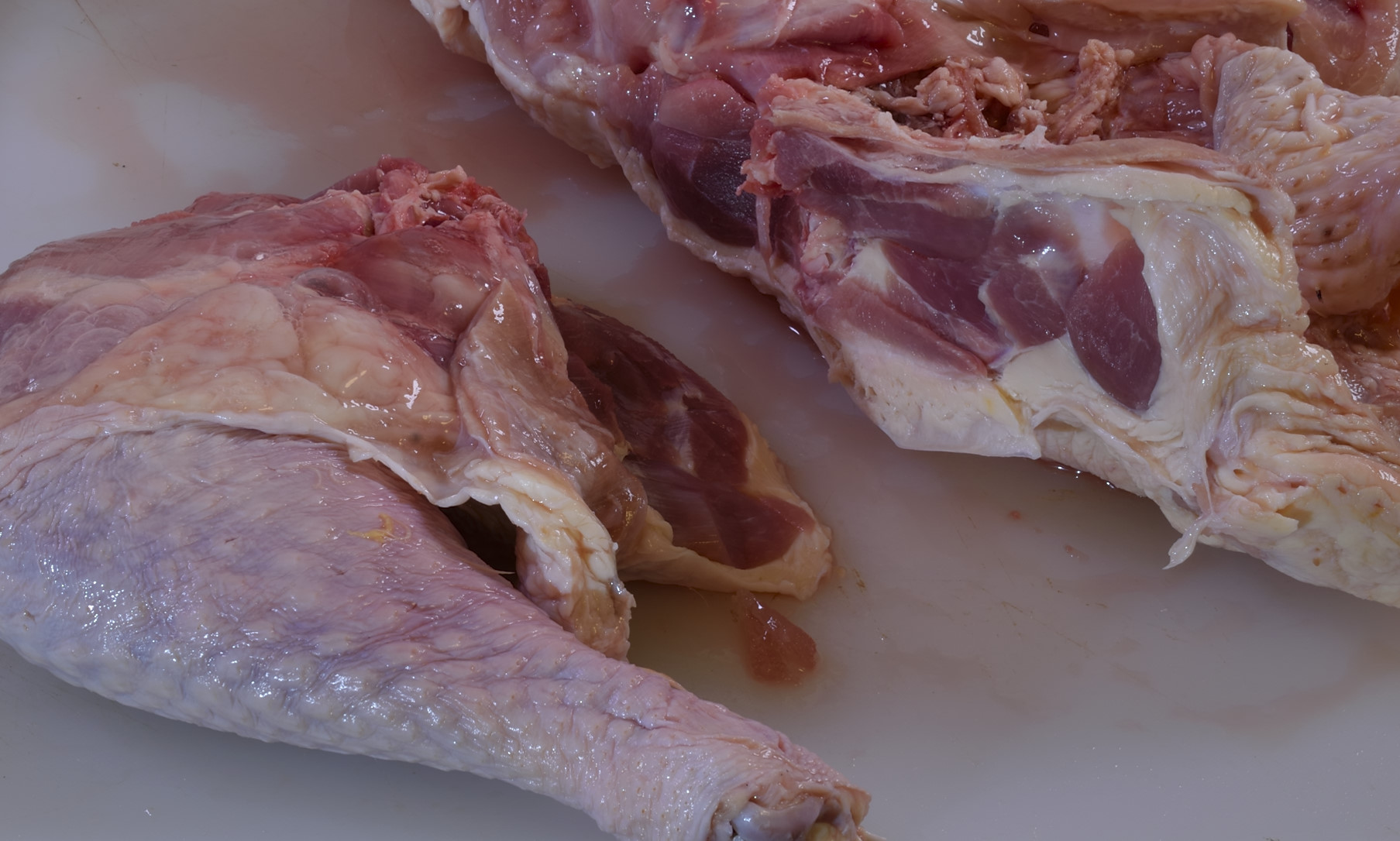
Finish removing the leg from the carcass. Repeat on the other side.
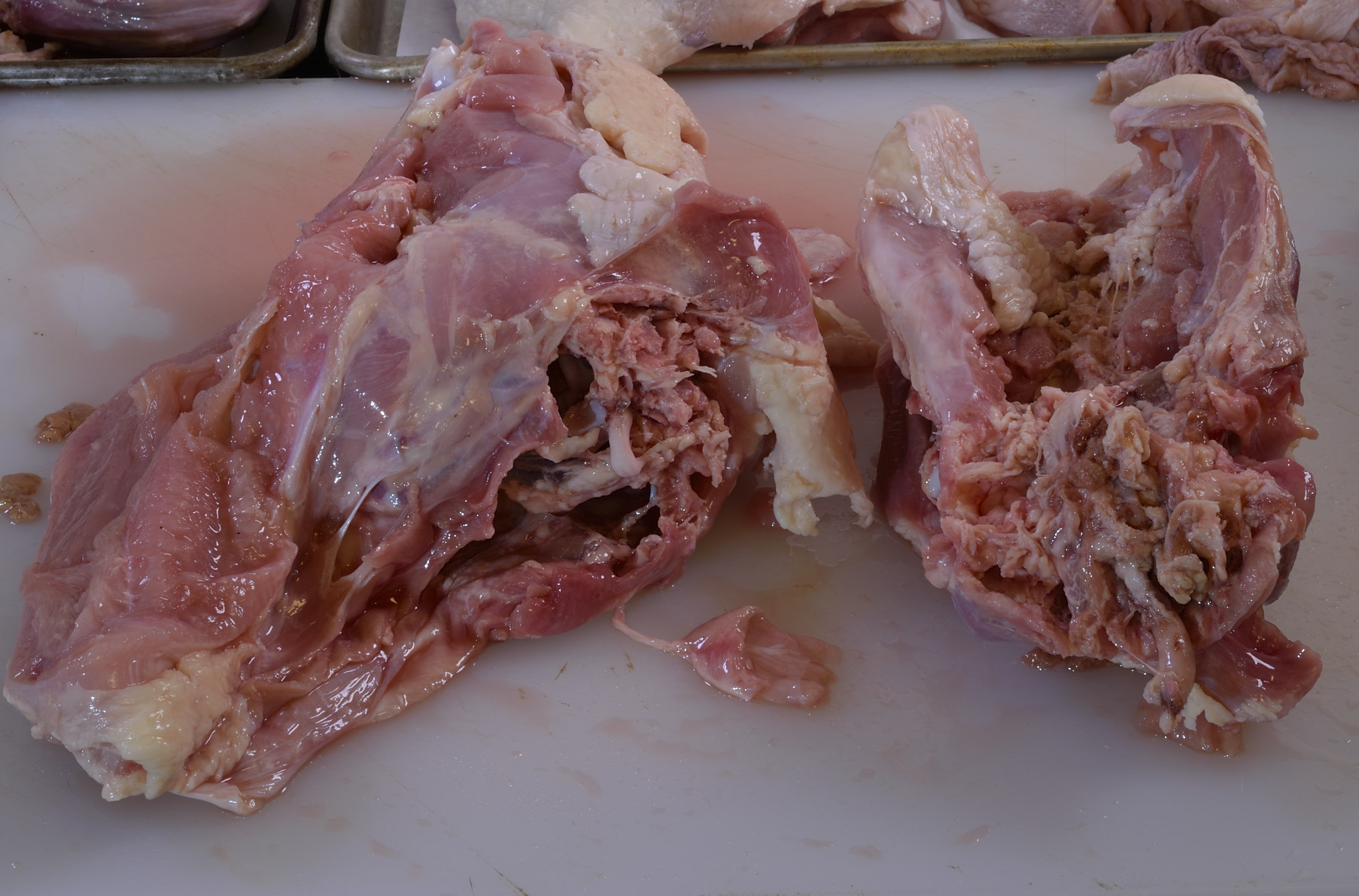
Separate the breast end from the leg end–again, if you bend the carcass “the wrong way,” it will snap, and then you use the knife to finish separating the two pieces–this just makes them easier to fit on the roasting pan.
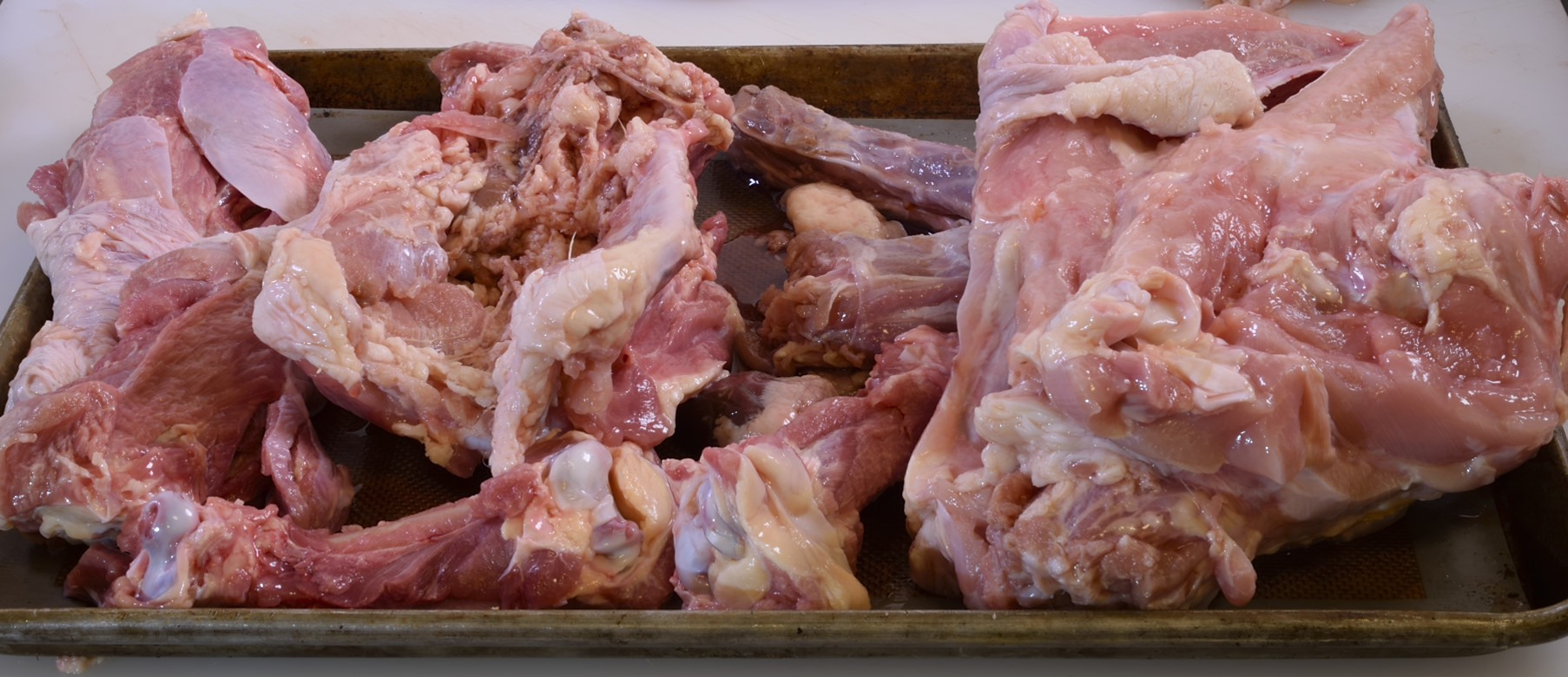
I removed the thigh meat from the bone and SOME of the meat from the legs, because it’s not Thanksgiving right now and that’s the only time anybody really cares. We made ground turkey out of all the dark meat.
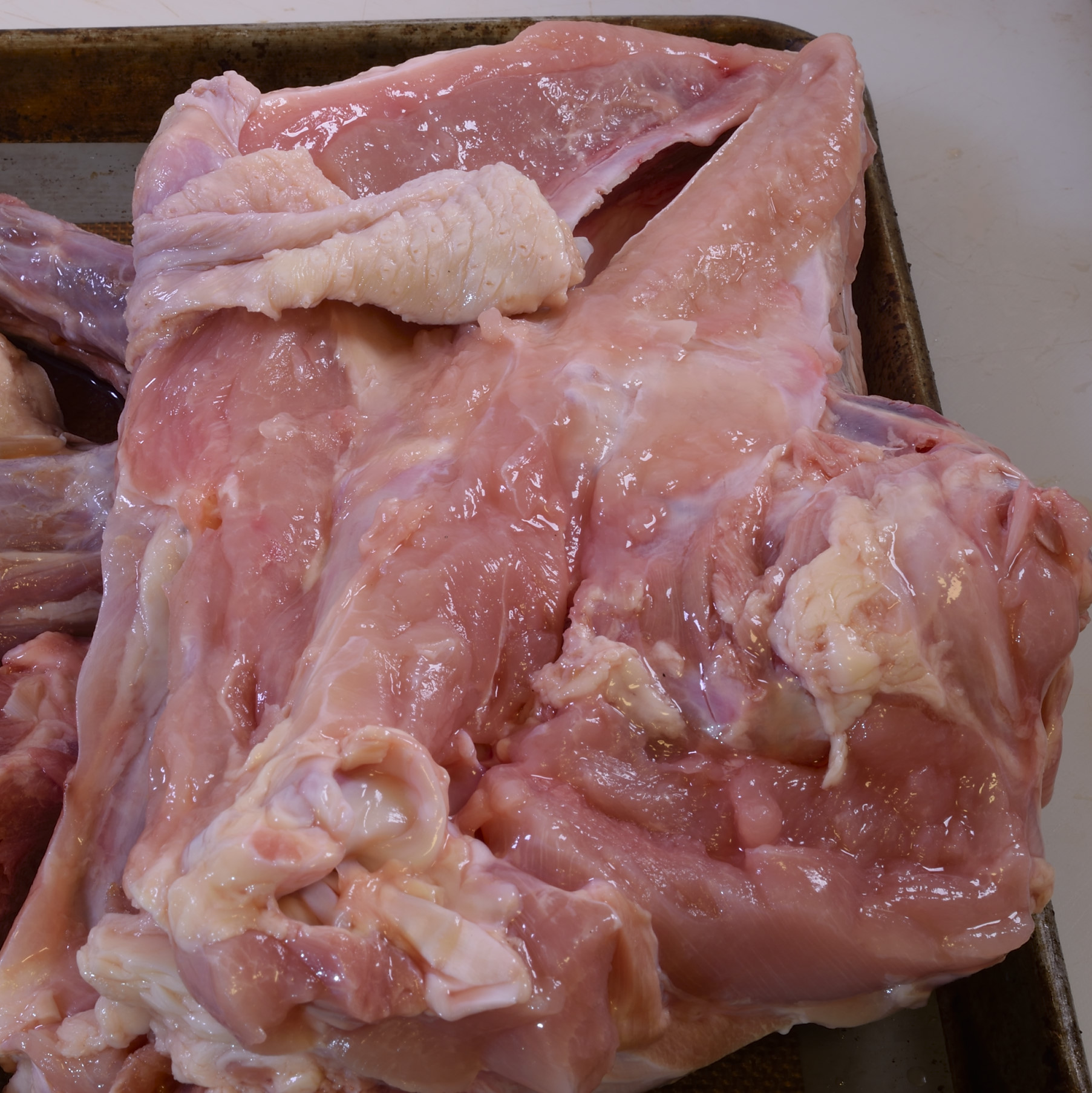
Ready to roast for the killer sauce.
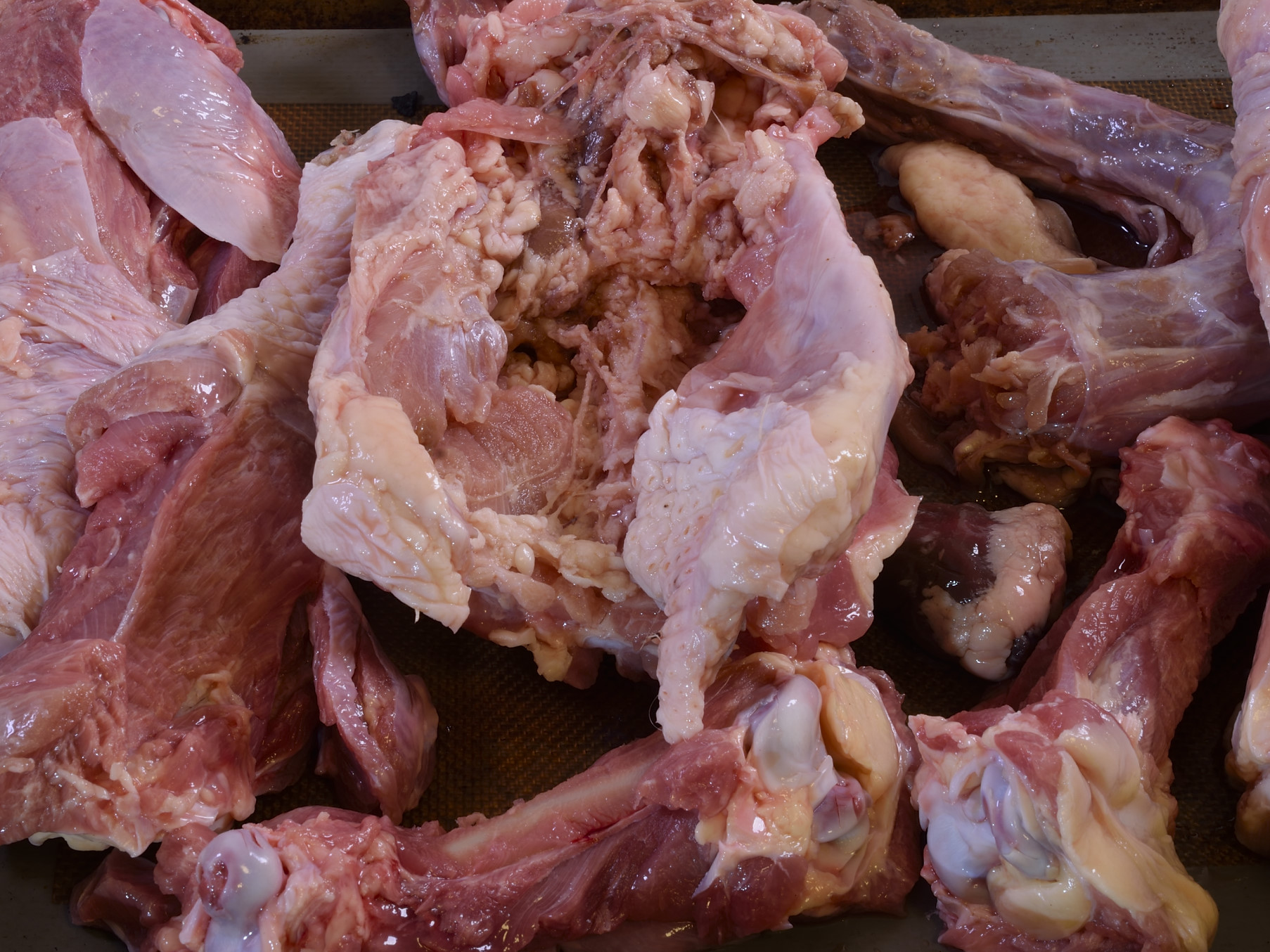
There is going to be meat left on the bone. At $150 lb/ you can waste a LOT and still harvesting an incredible bargain.
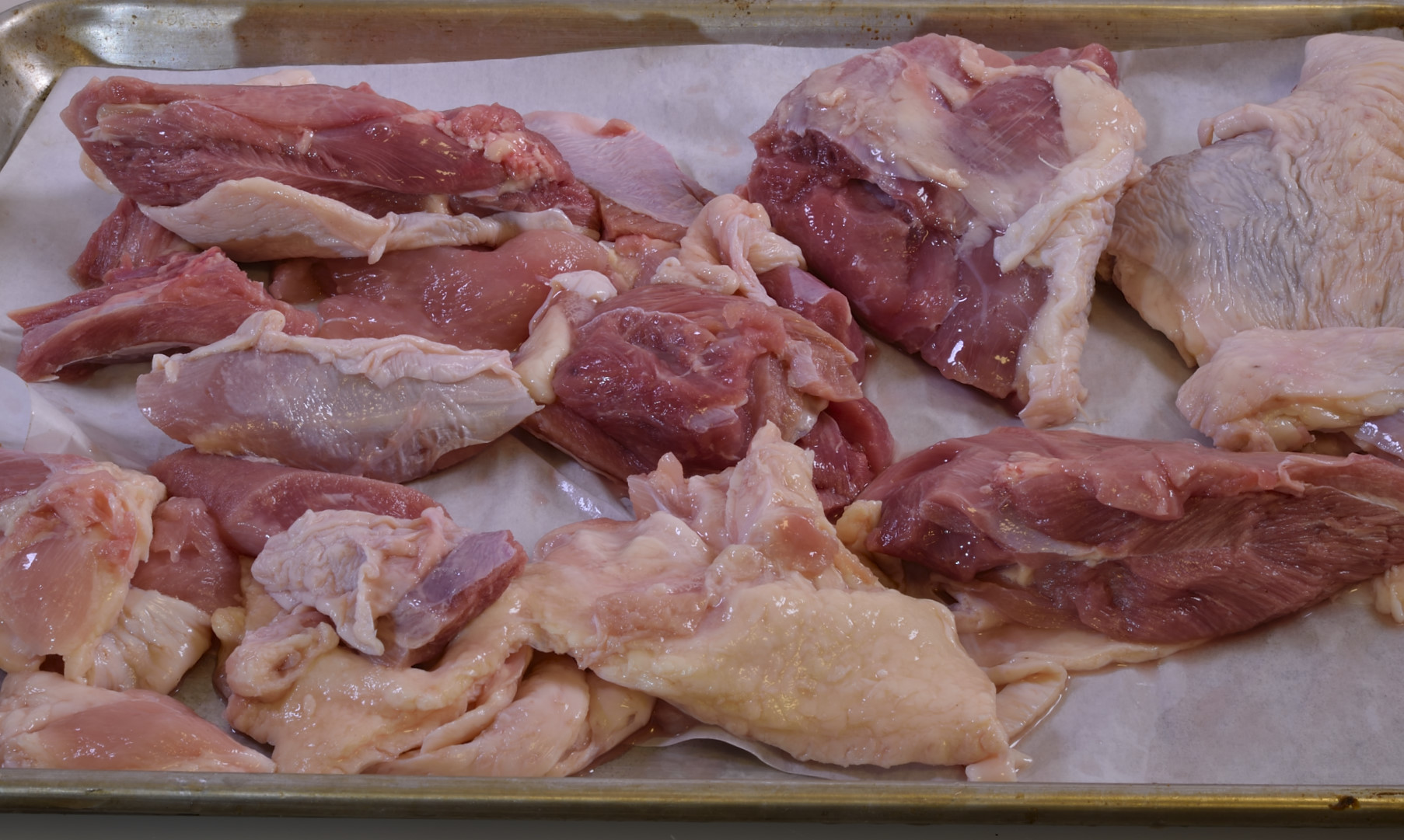
All the dark meat, extra skin, etc.–we’re going to make turkey burgers this time. Also suitable for turkey sausage.
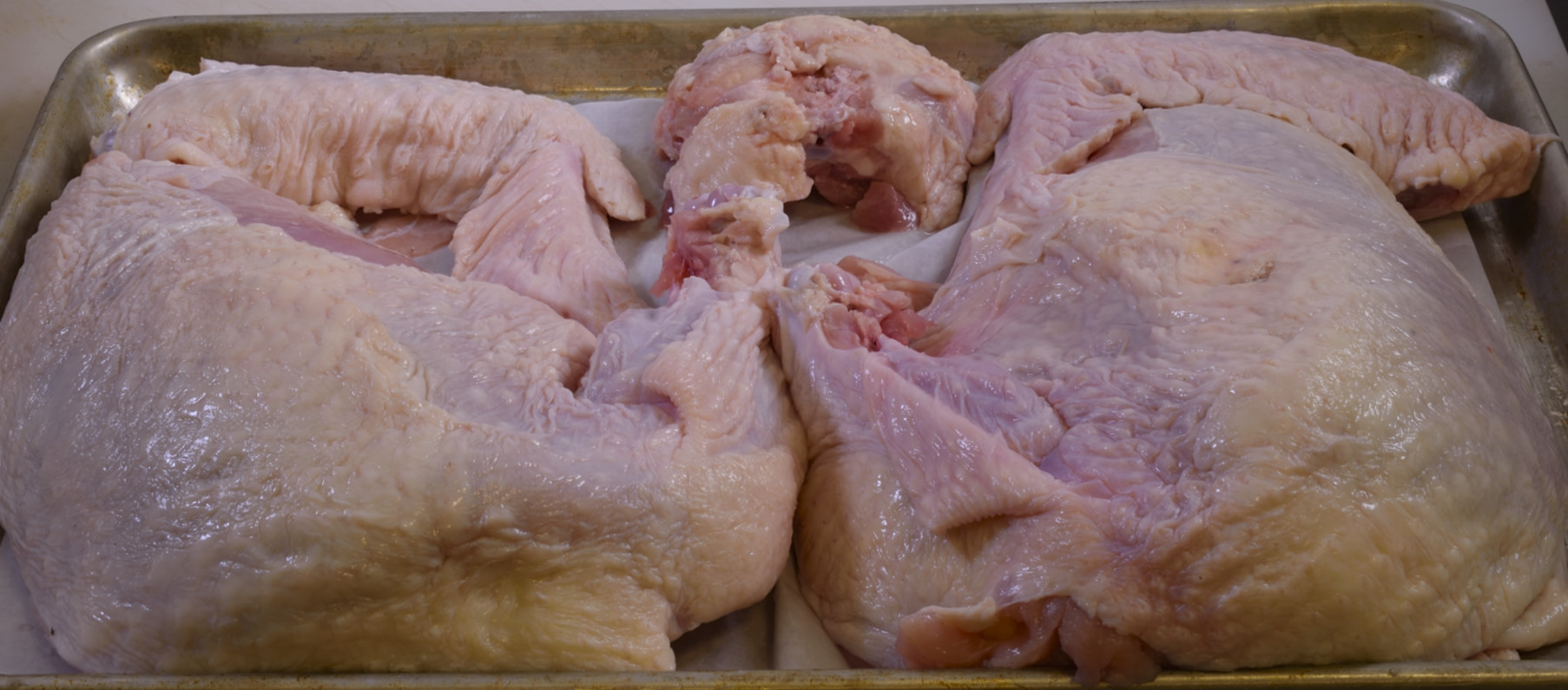
The breasts set aside.
No wonder turkeys can’t fly.
